~ WINTER SQUASH (PUMPKINS) ~
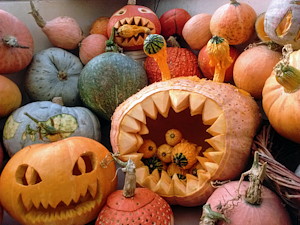
We REALLY like squash - they're easy to grow and filling. In our squash trials, we have found varieties that we think are quite simply amazing in terms of earliness, yield, and flavour.
Sow squashes in late April or May in small pots with some heat, and plant out when the third true leaf is just starting to open. Harvest in autumn when they are fully mature - how long they will store after that depends on the variety.
Small screen: Turn your device sideways to view sowing calendar.























































 = normal sowing & harvest time
= normal sowing & harvest time![]()
 = also possible depending on conditions
= also possible depending on conditions
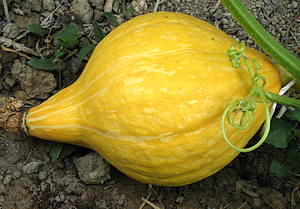
Golden Hubbard
This yellow variety is a recent addition to the Hubbard family, bred in Europe, with lovely yellow skin and the usual delicious flesh. It keeps really well over winter too.
Hubbard squash as a class were first introduced to the general public by seedsman and philanthropist James J.H. Gregory, in Marblehead, USA.
He wrote in 1857:
"Upwards of twenty years ago, a single specimen was brought into town, the seed from which was planted in the garden of a lady, now deceased; a specimen from this yield was given to Captain Knott Martin...who raised it for family use for a few years, when it was brought to our notice in the year 1842 or '43. We were first informed of its good qualities by Mrs. Elizabeth Hubbard, a very worthy lady, through whom we obtained seed from Capt. Martin. As the squash up to this time had no specific name to designate it from other varieties, my father termed it the 'Hubbard Squash.' JJHG, 1857"
It did very well for us in trials and we hope you'll enjoy growing it too!
![]() 12 seed
£
12 seed
£
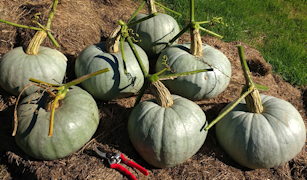
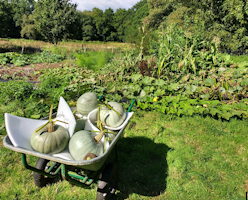
Volskaya Grey
We're really excited to bring you this squash from the Volga region of Russia, a medium-large (up to 10kg or so) mid-season blue-grey squash that gains a pink blush in storage.
This is a tasty, reliable and productive variety that is great for a whole range of recipes. We particularly like it chopped up and roasted with whole garlic cloves & chunks of red onion.
Original squash seed collected by Tom Hartley's mother in Russia. Stores well.
![]() 10 large seed, £
10 large seed, £
Stock:
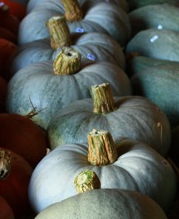
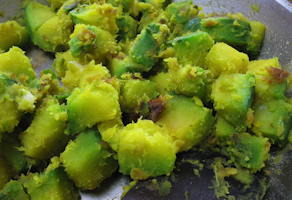
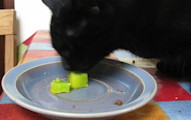 Blue Hungarian
Blue Hungarian
A rounded squash, with blue-grey skin, and the skin is quite thin and easily peeled, with very pretty yellow-green-orange flesh inside. Tastes great - fries up really nicely in chunks with olive oil, garlic and rosemary as pictured.
We got fruit with an average weight of 2.5kg / 5 lb here in Wales.
Stays together & doesn't go mushy when cooked, so really good for curries, stews, roasts etc. So yummy even the cat likes it. Stores well.
![]() 10 seed £
10 seed £
Stock:
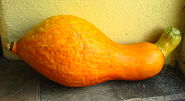 Boston Squash
Boston Squash
This is an very nice, widely adapted, ultra-early yellow hubbard squash for short-season areas. It makes beautiful large (sometimes very large) fruit, often with a slightly crooked shape.
The original seed was given to a Mr J M Ives in 1831 by a friend, so we can see that it has stood the test of time well.
It is a good big hubbard, with beautiful yellow-orange skin. The skin helps it keep for a long time, starting out yellow and then turning golden orange after midsummer. Vigorous vines and very productive, even in cooler parts of the country.
![]() 12 seed £
12 seed £
"Hi there, Just wanted to let you know that my husband and I grew your Boston Squash on our allotment this year, and (with minimal gardening expertise) one plant achieved a squash which weighs in at 2 stone 5 pounds! We are the envy of the allotments, which is lovely for beginners. - Alex Clark
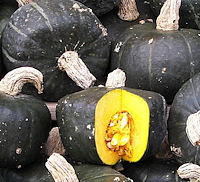 Burgess Vine Buttercup
Burgess Vine Buttercup
Considered by many to be one of the best eating squashes ever, this vine produces heavy, 9 inch, round, dark-green squash with a lighter green 'button' underneath. It has a thin skin and extremely dense flesh that can be roasted or used for pies.
We like it because it keeps well but is easy to peel. All buttercups have dense rich flesh but the Burgess strain is even sweeter than normal.
This is a good choice for those with smaller plots as the vines are not too huge, but still make lots of squash just the right size for two or three people.
Excellent flavour, green squash, very dense with good tetxure.
![]() 10 seed,
£
10 seed,
£
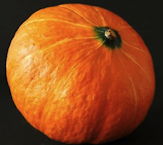
Hokkaido
This is a well-travelled squash - originally from Japan - now reslected for our northern climate, & it does well here. It is from the 'hubbard' family of squashes, which is one of the earliest and easiest groups of squashes to grow in the UK.
The flesh is dense, with a good flavour, and it keeps well. Always popular!
![]() 12 seed
£
12 seed
£
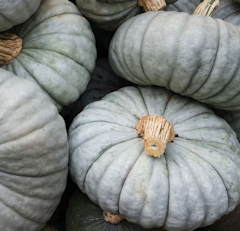
Piachenza Beret - a medieval hat squash NEW
From Piachenza in northern Italy, this excellent heirloom variety is named for its resemblance to a traditional medieval peasant’s beret, with gathered pleats.
The grey fruit are round, flattened, and slightly ribbed with yellow flesh, growing to about 5lb.
![]() 12 seed
£
12 seed
£
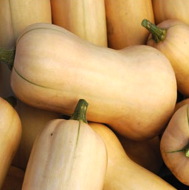 Waltham Butternut
Waltham Butternut
'Waltham' is an improved version of the common Butternut squash: It has very little seed cavity, thicker & straighter necks, fruits earlier, and produces more flesh per fruit.
It was bred by the Massachusetts Ag. Extension Service in the 1960's by crossing 'New Hampshire Butternut' with a wild African squash.
When growing Butternut squash, you need to be sure you have an early strain. This one is great! The orange flesh stays firm when cooked, and it stores very well too.
Reliable, productive. Long-keeper.
![]()
 12 seed
£
12 seed
£
Note: Traditionally, Butternut is one of the main squash types used to make pumpkin pie.
But in fact any dry-fleshed, dense squash works well. You can also
make very nice pumpkin tartlets using a muffin tray! Here are some Kate
and Josie made for Halloween.

Thelma Sanders Sweet Potato Squash.
A great Acorn Squash. The pale heart-shaped fruit are pointy and have gentle fluting down the sides. When mature, you can simply cut them in half and bake in the oven. (Though of course there are other options for the experts - Kate's mother once made a very fine acorn-squash soufflé!)
Originally collected by Tom & Sue Knoche in Ohio, USA; very productive & tasty, but no idea why it got that name!
 10- 12 seed, organic
£
10- 12 seed, organic
£
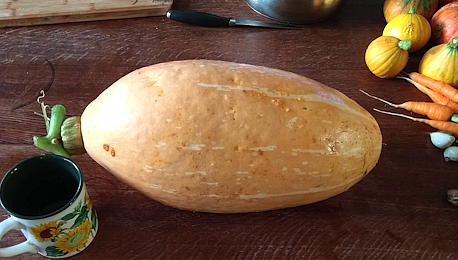
Jumbo Pink Banana
A large storage squash from the 1890’s, with really good dense flesh that cooks well. Originally domesticated by the Incas in South America, Banana squash were introduced to the seed trade by the Shumway Seed Co in 1893, and this variety is still true to the original description.
Easily peeled with good orange flesh, it keeps well. The vigorous vines can be extremely productive.
![]() 12 seed,
£
12 seed,
£
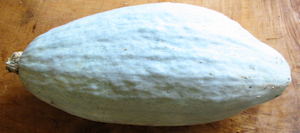
Blue Banana VERY RARE
This incredible squash makes attractive, long fruit like a pale blue zeppelin! An heirloom from Guatemala that grows rapidly, producing lots of grey-blue fruit . A waxy skin that keeps it fresh for ages, but is very thin and easily peeled. This is the best of the three 'banana squash' varieties still in existence.
Really easy to cook - just slice across it and you get handy rings of squash - easy to deseed and quick to trim off the skin. Very nice in a risotto, see the picture.

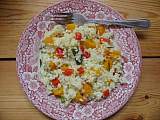 Easily peeled with good yellow flesh, it keeps well - stored from October, we cooked the last one in April!
Easily peeled with good yellow flesh, it keeps well - stored from October, we cooked the last one in April!
10 seed, £
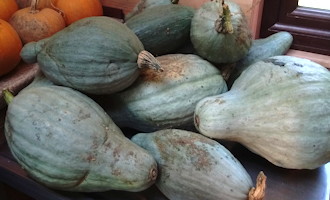
This is a really, really good variety from the 'Hiram Sibley & Co' seed catalogue of 1850, that grows well in the UK (pictured in our barn in Wales). It ripens nice and early, making lots of grey pear-shaped squash weighing about 3kg / 6lb. They have a very dry dense yellow flesh, and keep well overwinter.
Save some in storage as they become noticably sweeter after the New Year. Good for pies, roasting etc, but particularly excellent for warming winter soups and stews.
Keeps its shape when diced & roasted, also makes a very hearty thick soup.
![]() Packet of 12 seed
£
Packet of 12 seed
£
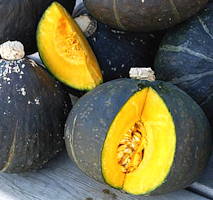
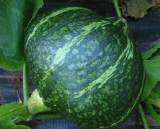
'Anna Swartz' Hubbard
The best of our 2006 squash trials, and very popular ever since. In the 1950's this nice green squash was passed to a woman called Anna Swartz by a friend. She kept it going, and passed it on to a seed-saving group, from where ultimately we got a few seeds to try, as it was highly recommended.
It lived up to its reputation! The plants had hardly germinated before they were off and making a bid for freedom - the vines are big and very fast-growing and set fruit quickly. This variety is a great choice for cooler or shorter season areas of the UK.
Like most hubbards, it has a very hard skin, which means that they keep exceptionally well. The flesh is very sweet and dense - all in all an excellent squash.
 12 seed, organic
£
12 seed, organic
£
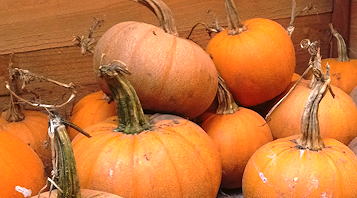
This is a super-early Jack O’Lantern type pumpkin. It is a very prolific and productive pumpkin, with a particularly good flavour. We got a huge number of fruit in our trials from only 12 plants, pictured here stored in our barn.
A medium sized pumpkin - the fruit average about 2kg / 4lb , and a really nice colour - orange with a slight netting. Like most Jack o'lantern types, it will store for a few months but needs using before Christmas.
The special thing about this variety is that as well as being early enough for Halloween, it tastes really good - ideal for roasting and pies as well as soups.
Early, round orange pumpkin, with a particularly good flavour. Pictured in our barn.
 11 seeds, organic
£
11 seeds, organic
£
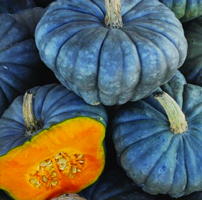
Queensland Blue
A large, ribbed blue squash first introduced in the 1932 Arthur Yates & Co Seed Catalogue. We've added this to our seed list because it has particularly rich sweet orange flesh, is quite early to set fruit, and even stores well overwinter too.
It makes great squash for us in Wales, and we think it should do well in most parts of the UK.
![]() 10 seed £
10 seed £
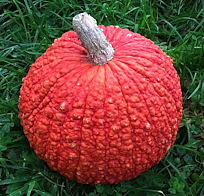
Victor
Originally introduced by James J. H. Gregory of Marblehead, Massachusetts in 1897. The huge glowing fruits start out smooth & pale yellow, then eventually turn orange and later ripen to a redder colour, covered with small bumps.
A hubbard type, with a hard skin (so it stores well) and has a really good flavour.
Thought to have been lost forever, but recently resurrected from the U.S. Seed Bank.
![]() 12 seed, £
12 seed, £
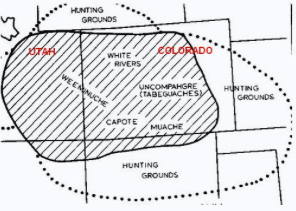
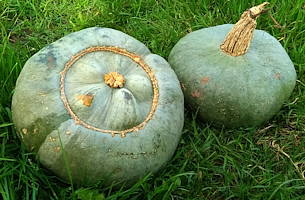
Ute Indian EXCELLENT FLAVOUR
Added from our trials, this is very productive, and really tasty as well.
Shaped like a green Turks Turban squash, with a huge 'button' on the bottom, this ancient variety is from the native Ute people who lived Colorado from AD 1300 to 1881. The flesh is rich and dense; all in all an excellent squash.
It has a really, really good flavour!
![]() 12 seed £
12 seed £
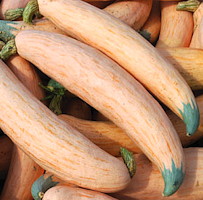
North Georgia Candy Roaster NEW
A beautiful old squash from Appalachia, weighing up to 10 pounds, with a pretty greenish-blue blossom end mark.
Very rare! Smooth, delicious orange flesh, perfect for baking, frying and making pies.
![]() 12 seed £
12 seed £
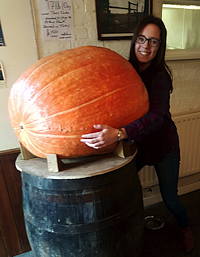
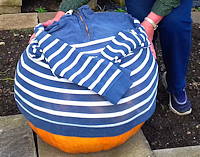
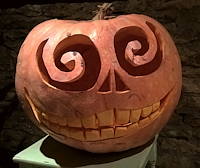
This is a new amateur variety from Holland, which has been bred from the famous 'Dills Atlantic Giant' pumpkin.
We can't guarantee exactly how big the pumkins will be - as it depends so much on the weather and soil, but they really should be very large: we got 27.1kg in the back garden without any special care. Others got about 50kg!
What is really nice is that the plants themselves don't actually take up that much space, and the squash have a good flavour, so you do get to eat them as well. The flesh is crisp and sweet and can even be eaten raw like carrot sticks, or is delicious roasted or cooked in the usual manner. You definitely will not run short of pumpkin soup with this one!
Pink , very large pumpkins
![]() 12 seed £
12 seed £
"Wonderful seed. Nearly 2 tons of squash and pkins off our patch. .. this one is 171lb" - Jeremy Newson
"It weighed a lovely 44kg, so we only just managed to lift it! As you can see, it made a truly impressive Halloween lantern, although it did take all night to carve it." - David Coop
"I planted one at my allotment and it weighed in at 7 and a half stone - or 105 pounds. I didn't know how we were going to lift it but eventually came up with the idea of enrobing it in an old sweatshirt, turning it upside down - and then two of us were able to lift it into the wheelbarrow by the arms! We managed to break the wheelbarrow in the process but did get it into the boot of the car and then used a saw to cut it into quarters back at home. So far, it has made 7 batches of soup, 6 pumpkin pies and a pumpkin and parsnip casserole = delicious! " - Helen Pottinger
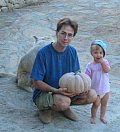 A
note on . . . . the Harvest and Storage of Winter Squash
A
note on . . . . the Harvest and Storage of Winter Squash
If handled correctly, they will keep for a long time. For biggest and densest fruit, leave the squash as long as possible on the vine, even after the leaves start to die down, unless there is danger of frost.
Harvest by cutting the vine either side of the stem, not cutting the stem itself. Bring inside and store in the warm for 10 days for them to cure. Ideally this is 80F / 25C, but we just keep ours in the kitchen where is is reasonably warm.
Curing like this makes lets the skin dry out and lets minor damage heal. It really makes them much longer-keeping and they can then be stored at a cool but not cold temperature (experiments prove that 55F / 12C gives the longest keeping) .
We use a spare
(unheated) bedroom which is perfect in our not-very centrally heated house; but a frost-free garage will do
at a pinch. A shed will probably get too cold overnight and too hot during the day. This storage temperature is important to get right - check with a thermometer - too cold and they will rot.
Saving Squash Seed:
It's no good just keeping some seed from any old squash you have grown. Squash are very promiscuous! & will cross with others nearby.
You have to hand-pollinate the flowers to keep them true to type. Simple, but really necessary if you want next years sqush to be anything like this years' , so read the instuctions in the seedsaving link on the left. (The rubber bands are to stop the insects getting in and crossing them)

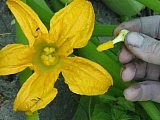
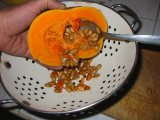
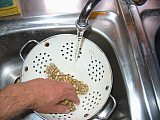
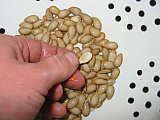

Here we are a couple of months later, scooping out the seed. Wash in lots of cold water until not sticky, pick out any duds, and tap out onto a plate to dry.
There's more detail in our free seed-saving leaflets that you can find in the sidebar on the left.







